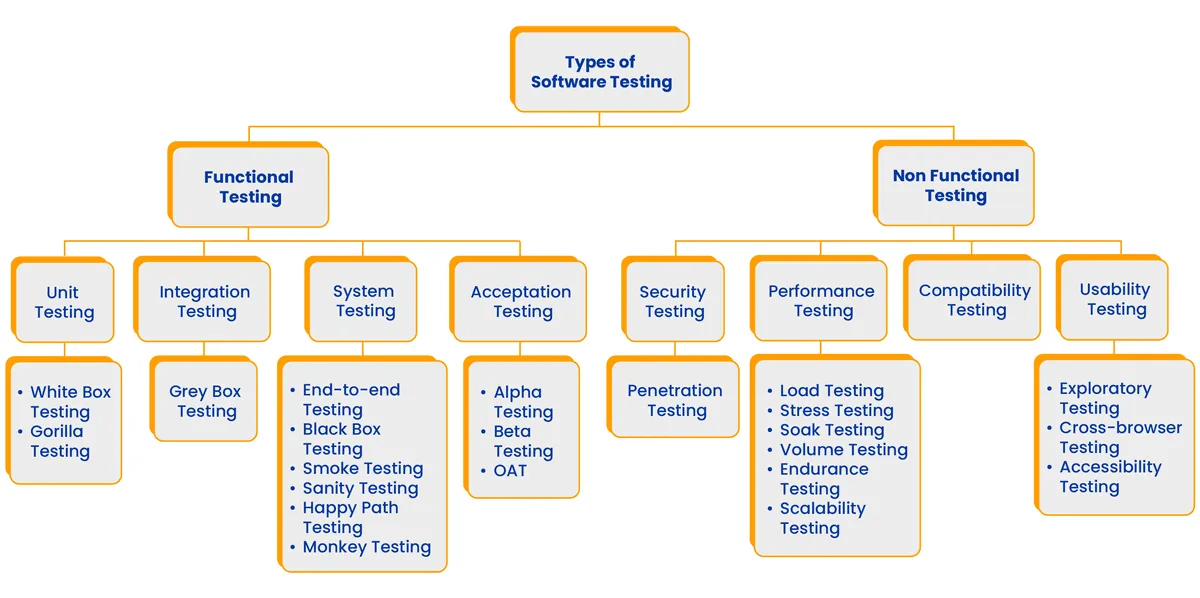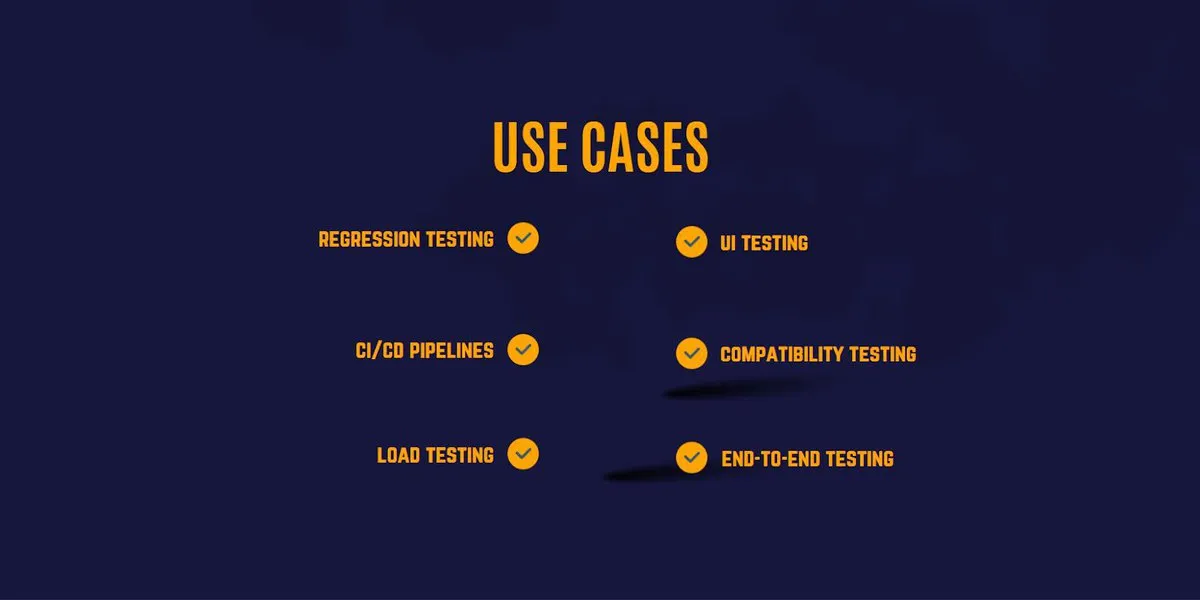After spending hours or even days manually testing your software, you may be wondering whether or not there’s a better way. The good news? There is.
Enter: test automation
Software test automation not only minimizes the manual work of writing test scripts, but other teams within your organization, and even your customers, can benefit from it as well. In this blog, we’ll explain what software test automation is, which automation testing tools are best–including their benefits and use cases–and key considerations when creating a test automation strategy.
What is test automation?
 Automated software testing is the practice of creating, running, and analyzing tests automatically (typically with specialized tooling and testing frameworks), with the goal of minimizing time-consuming and repetitive tasks experienced by manual testers. While using a software test automation platform is certainly gaining traction in the development world, many tests are still run manually, resulting in some setbacks for development teams such as:
Automated software testing is the practice of creating, running, and analyzing tests automatically (typically with specialized tooling and testing frameworks), with the goal of minimizing time-consuming and repetitive tasks experienced by manual testers. While using a software test automation platform is certainly gaining traction in the development world, many tests are still run manually, resulting in some setbacks for development teams such as:
- Human error
- More time spent testing software than developing new features
- Limited number of test cases and coverage
- Inconsistent tests
These are just a few examples of how manual testing can negatively impact an organization, which is why automation testing has been heavily adopted. Software test automation frees up time and ensures that tests are repeatable. As with everything in the world of software, however, test automation is evolving. These days, it’s not uncommon to see even test creation becoming automated.
Types of automated software tests
A software test automation tool can write automated test scripts for various use cases. At a high level, software testing can be divided between functional testing and non functional testing.
Functional testing
Functional testing covers matching user requirements like features, while non-functional testing covers the properties of an application like its speed or security. Functional tests can be written at various scopes. The smallest is unit testing, which isolates components of an application into small unit tests. One step higher is integration testing which is for running tests on parts of a system. The largest type of functional testing is acceptance testing which encompasses QA testing against real user needs. Smaller types, like unit testing, are more optimal for running automated QA tests, while acceptance testing is more aligned with human intervention and manual testers.
Non-functional testing
Non functional testing is also key in test design for your test suites. For example, you can use usability testing like browser testing or mobile app testing to get test data if your app works on a wide range of platforms. Performance testing can also ensure your web applications, desktop applications, and mobile applications are scaled to serve your traffic requirements. Testing frameworks like Speedscale can create test data from your own production traffic to performance test your apps. 
Manual vs. Automated Testing
Looking at the relative complexity that can be automated testing, you might wonder what the difference is practically between manual and automated approaches. Let’s take a look at this now.
Manual Testing
Manual testing is the process of having testers interact with APIs through systems like Postman, Curl, or web interfaces, manually sending requests and verifying responses. This is an entirely manual process, with everything from crafting the response to reporting the final testing taking place via human effort. This can allow for more granular testing of edge cases and specific applications, but it requires significantly more effort and tooling.
Advantages
- Manual testing is good for exploratory testing or early testing when the API in question is still in early development.
- This approach is highly flexible and does not require upfront scripting or setup, which can give the illusion of high-cost performance.
Challenges
- The cost performance is mostly an illusion, however - this process is time-consuming and less efficient for repetitive testing, which introduces greater cost over time.
- Manual testing is also highly prone to human error.
- It’s also quite difficult to ensure consistency across repeated tests.
Automated Testing
As mentioned earlier, automated testing involves using scripts and other automated systems to run predefined or templatized tests across APIs without any human effort. The scripts can use solutions such as Postman Collections or REST Assured to process the testing and often generate logs and detailed reporting on the output of this testing regiment.
Advantages
- Automation is faster and more efficient for large-scale or repetitive testing.
- It provides consistency and eliminates human error, especially for complex and rote tasks.
- Automated testing can easily be integrated into CI/CD pipelines for continuous testing.
Challenges
- It has the illusion of high cost, requiring initial setup time and scripting expertise.
- Automation is arguably less flexible for exploratory or creative testing, although it’s not impossible to have this in an automated setup.
- Maintenance is needed when APIs change, which can introduce additional complexity in the long term.
Key Differences
Aspect
Manual Testing
Automated Testing
Effort
Requires more human effort
Requires initial setup effort but minimal for execution
Speed
Slower due to manual intervention
Faster for repetitive tasks
Scalability
Limited scalability
Highly scalable
Flexibility
Highly flexible for new scenarios
Less flexible for exploratory tests
Consistency
Prone to variation/human error
Highly consistent
Cost
Low initial cost but higher long-term (time-intensive)
Higher initial cost but cost-efficient long-term
Why Do You Need Automated Testing?
 Knowing the benefits of software test automation is only one piece of the puzzle. Arguably, it is more important to know where to implement it. Not all tests are suited for automation. Exploratory tests, for example, are intended to explore the system. Below you’ll find best practices and use-cases for implementing test automation.
Knowing the benefits of software test automation is only one piece of the puzzle. Arguably, it is more important to know where to implement it. Not all tests are suited for automation. Exploratory tests, for example, are intended to explore the system. Below you’ll find best practices and use-cases for implementing test automation.
CI/CD pipelines
The point of setting up a CI/CD pipeline is to automate the development and deployment of software. Therefore, it makes perfect sense that software test automation and CI/CD should be combined. When implementing a CI/CD pipeline, you configure it to verify that a given set of checks is passing. So, having software tests run automatically will greatly increase the efficiency of your CI/CD pipelines. Additionally, combining test automation with CI/CD provides confidence that the software you’re delivering to customers is solid.
Regression testing
Regression tests can be some of the most repetitive, predictable, and stable tests to perform. The point is to make sure that all existing parts of the application will still work as expected after introducing a new feature. Overall, regression tests are very suitable for automation because they need to be run quickly, consistently, and reliably.
Load testing
One area that has yet to see a big embrace of software test automation is load testing, but it is becoming more common. Load testing is designed to evaluate the performance and resilience of an application, making sure it can withstand a given amount of load. By combining test automation and load testing, you can make the system steadily increase the load to your application, allowing you to know exactly how much load your application is capable of handling. Be sure to keep these considerations in mind when load testing. Lastly, you may be interested to learn more about a new way to implement automation for load testing, using production traffic replication.
End-to-end testing
End-to-end testing is meant to evaluate all parts of your application from start to finish, making sure that everything works together as expected. This is accomplished by simulating real-world usage of your application and verifying that it handles regular user interactions.
The biggest hurdle in end-to-end testing is the setup. Because you need all parts of your application to work together, setting up an environment can be quite a task in itself. For this reason, many organizations choose to bypass end-to-end tests.
UI testing
Testing the user interface (UI) is traditionally done by opening up the web app and then manually clicking around to verify that everything works. Not only is this a very time-consuming and tedious process, it’s also one of the most error-prone types of manual testing. Implementing software test automation here will ensure that you discover any usability or design flaws more quickly–and consistently. In UI testing, it’s somewhat common for bugs to go unnoticed because the UI hasn’t been tested on a specific combination of device and browser. With test automation, testing for this is not a problem. Also, as with load testing, there are tools that can record user interactions in your application, which you can then play back, ensuring that your tests cover real-life use cases.
Compatibility testing
Getting started with compatibility testing can be a big undertaking for any organization, especially when done manually, as the number of test cases can quickly increase. Imagine that you have a mobile application to test on two devices and two different OS versions, with ten test scenarios to run.  Now imagine that there’s another OS version and another device you need to test.
Now imagine that there’s another OS version and another device you need to test.  See how just two more variations to the compatibility matrix added five more devices? This is just a simple example, and in the real world you are going to have many more devices that need to be checked against your mobile applications. Because of this, compatibility testing is a perfect candidate for test automation.
See how just two more variations to the compatibility matrix added five more devices? This is just a simple example, and in the real world you are going to have many more devices that need to be checked against your mobile applications. Because of this, compatibility testing is a perfect candidate for test automation.
Why Is Automation Testing Crucial?
Automated testing allows for the shifting of process development, test automation framework development, test maintenance, and more away from active development. Testing is an ongoing and critical function of any software development process, and this is especially true of the application programming interface, which might touch millions of data points in mere months. Automation testing unlocks some huge benefits - let’s talk through some specific benefits.
10 Benefits of Automated Testing

1 - Automated Testing Reduces Human Error
Manual testing is highly prone to human error. Human error can easily waste time by causing developers to debug working software and can impact the customer experience if a manual test fails to catch a bug. Incorporating automation in your software testing process can minimize human error and bring consistency to your testing process. Additionally, implementing software test automation provides the opportunity to build test plans, effectively codifying and documenting your tests along the way–a great help for new software developers and testing teams joining your organization.
2 - Test Automation Makes Feedback Loops Faster
Test automation introduces faster feedback loops and, subsequently, faster bug fixes! When manual test results take too long to return results, teams may often feel inclined to skip the tests altogether and deploy the new feature without full test coverage (we admit, this has happened once or twice…). Implementing test automation helps ensure these risky shortcuts are no longer necessary.
3 - Automation Increases Test Coverage and Scalability
Because automated tests can be run quickly and efficiently, developers can execute a large amount of test cases in a short amount of time, accelerating the testing process. A faster testing process allows developers to test more features, or even experiment with unique edge cases, ensuring that all parts of the software meet a high standard of quality. Automated software tests cover more use cases and code. For example, a single API endpoint can be tested in several ways:
- Positive – Valid request and expected response
- Negative – Invalid request expected error response
- Boundary – Test request with values at the boundaries of valid ranges
- Missing parameters – Validate error handling of missing information
- Extra parameter – Validate error handling of malformed request
And the list goes on… All the tests can be run for a single endpoint with a single behavior. Now, think of the numerous endpoints you have and the different behaviors expected from each endpoint. Does the response change based on the user’s authorization? Does it change based on parameters like ?sort=name? Can you change the behavior with certain parameters, such as ?mode=compact? This is before considering how it reacts to different request bodies. Hopefully, it’s clear that it’s unlikely to test all possible API scenarios. Although test automation doesn’t guarantee you’ll test 100% of your code, it comes much closer than manual testing. As a result, developers will spend less time “fighting fires” and troubleshooting because they’ll be notified of bugs earlier in the development process and fix them before deployment. Even if you only use software test automation to replace existing test execution, it will likely increase your efficiency significantly.
4 - Automated Testing Improves Application Performance and Stability
Software test automation allows developers to not only run tests quickly and repeatedly but also consistently and reliably. These quality assurance checks happen much earlier in the software development life cycle, which ultimately results in much more stable software. Increasing stability, however, isn’t just about catching bugs in new code. It’s also about performing regression testing to ensure new code doesn’t impact existing functionality. Test automation lets you perform regression testing on almost every part of your application—an impossible feat with manual testing. Automating tests also lets teams have much more control over the environment. This provides better predictability and allows developers to test their applications in a wide variety of scenarios, including very specific edge cases. Automated software tests can also be run on a regular basis, such as nightly or weekly. For example, you might not want to run a fully automated test suite every time a developer commits a new feature. In that case, it might make sense to implement regular test runs of the entire application, making sure bugs don’t accumulate over time. All of the previous points come together to increase the quality of your software significantly. With fewer errors, higher coverage, and increased scalability, you can be much more confident in the software that you deploy. This is how companies such as Amazon are able to deploy thousands of times a day.
5 - Automated Tests Save Costs
Software test automation cuts costs in three main ways: infrastructure savings, engineering hours, and opportunity costs. Because test automation allows for the creation of preview environments, it reduces the resources you need to keep running 24/7. You can spin them up when they are needed and close them down when the test is done, which can lead to huge cost savings. Also, software test automation can add help by creating powerful comparisons. It isn’t an inherent feature of test automation, but it’s possible depending on how you implement it. For example, traffic replay can consistently generate traffic to determine the optimal Kubernetes cluster configurations.
6 - Automated Testing Delivers Better Business Metrics
Fewer bugs, more test coverage, and more time to spend on new features is music to the ears of every developer. When your software product performs well, other parts of your organization will benefit, too – here’s how: Quickly releasing reliable features is a major benefit of automating software tests. Faster time to market with reliable new features helps organizations react faster to market changes and get customer feedback earlier, leading to lower up-front and opportunity costs. When you thoroughly test applications, fewer bugs enter production, which improves the user experience. Any organization that prioritizes customer satisfaction should absolutely implement test automation. Your reputation will improve as the stability of your application increases and you develop new features that satisfy customers. It’ll get even better if you respond to customer feedback quickly. Word-of-mouth will always be one of the best marketing tactics. As business metrics and operations improve, your product needs to grow, too, especially if you’re a SaaS platform. However, unprepared growth can invalidate the benefits of test automation. Perhaps you implemented autoscaling rules because you expected a certain growth level. However, your application will become unstable if you don’t factor in the time to spin up new instances during scaling. In the best-case scenario, users will understand the situation and return later. In the worst-case scenario, users will lose interest in your product because of a negative first impression. If you’re expecting growth, implement automated tests for autoscaling. Collectively, all the above benefits cause revenue increases for businesses. Your revenue will likely grow if you have happy customers, reliable features, and high innovation potential.
7 - Reusability of Testing Scripts
Reusability is a huge benefit of automated API testing. By creating a test script that can be reusable in different methods and locations, you are essentially creating a suite of specialized tools that can be deployed across multiple projects, versions, and even iterations of the core API. What this ultimately means is that you can compound the benefits expressed above into other areas of the testing regiment. Efforts spent on one aspect of the API test can be replicated elsewhere, adding up over time to something more than the sum of its parts. This is particularly useful when considering the path of API evolution, as these tests can be adapted with minimal effort but major benefits.
8 - Consistency Across Environments
Environments can often change wildly, introducing new variables that can make manual tests and specialized test case applications more difficult in practice. By establishing a baseline automation process, you can ensure that your APIs are being tested with a known base even when the environments that the API operates across is wildly different. This applies both to singular API environments such as development and staging as well as operational environments where APIs might interact with one another in a more significant way. Consistent standardization of the testing approach means that your testing process doesn’t introduce its own issues. Human testers are humans, and so isolating whether the issue is an environmental variable or a human variable is a key part of testing the environment itself - arguably, automated testing is the only real solution that can help isolate these variables by its very nature.
9 - Improved Collaboration
Automated testing, once integrated into CI/CD workflows, can help teams collaborative more effectively. Since automated testing removes the ambiguity of each validation phase and makes comprehensive testing more viable across different environments, teams can work together with a common understanding of what is a valid code iteration and what is not. This increased visibility into both the automated testing process as well as the results of the overall system testing makes team flows more compatible, and ultimately has a net positive effect on collaborative tooling and workflows.
10 - Better API Documentation
Most good testing tools will provide significant information beyond just a pass-fail binary. Automated testing tools can facilitate everything from integration tests to exploratory testing, and the output of these detailed test reports can have significant benefit for API documentation efforts. First of all, this testing makes it significantly easier to tie the API behavior with the API functionality. Validation of the API contract can result in the documentation having closer coupling and more accurate information. Secondly, this testing can provide common areas of misconfiguration or poor default functionality, which, when documented, can help users avoid the same pitfalls. This can have significant benefits - for instance, performance tests can pinpoint specific areas where performance suffers, allowing users to bypass common issues that might drag down their own systems.
A developer’s guide to continuous performance testing
Key Considerations for Choosing the Right Test Automation Tools
Choosing the right software testing automation tool is crucial for success, no matter the situation. A good automation testing tool is simple to install, use, and maintain. Overall, it should provide a good developer experience and powerful functionality. But what functionality should you look for? Apart from generating and executing tests, it’s vital that automation testing tools can integrate with other parts of your development process. For example, if your test automation tool can’t integrate with your CI/CD provider, you won’t enjoy the full benefits of test automation. Yes, developers benefit from automatic test generation because it allows them to test larger parts of their applications. But the real power comes from continuous testing. For this, you need to integrate test execution into your existing workflow and validate functionality before merging a pull request. Some dev tools cover certain testing use cases for development teams, but you may need a purpose-built automation tool at times. For example, Speedscale allows you to replay traffic within a Kubernetes cluster. To send a single API request, however, you may want to use Postman. Although Postman lets you view necessary information, like request headers and parameters, manually adding the information to Postman is inefficient. Instead, proper integration allows you to export a Postman collection and import it into Speedscale, which ensures zero mistakes when transferring the request from Speedscale to Postman. In some cases, developers prefer the interface of K6 because you can export recorded traffic and use it to create K6 tests. Or perhaps you’ve already got monitoring set up in Datadog, and you like the monitoring and reporting abilities it gives you. In that case, your automated testing tool should be able to export data to Datadog. The point is that generating and executing tests isn’t enough, especially in a modern infrastructure like Kubernetes. Rather, integrating with other tools that enable flexibility is crucial for streamlining your development process.
Conclusion
Your software test automation strategy can significantly accelerate software delivery and help you avoid user reports of bugs and errors, wasted engineering hours, and limited coverage. However, test automation comes with a big up-front investment of time and effort, which some organizations cannot afford. As with every improvement in software development, it’s important to perform a cost-benefit analysis on any new initiative. Test automation frameworks, however, don’t need to be one complete overhaul–they can be tackled in increments. If your web applications are running in Kubernetes, you can quickly get started with automated load tests in Kubernetes as a next step.